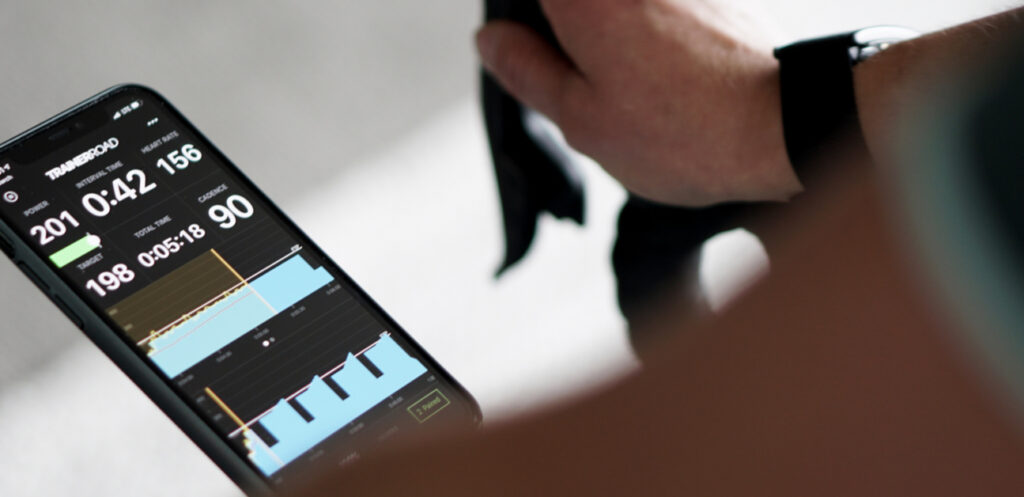Stretches for Cyclists: 5 Stretches You Should Know
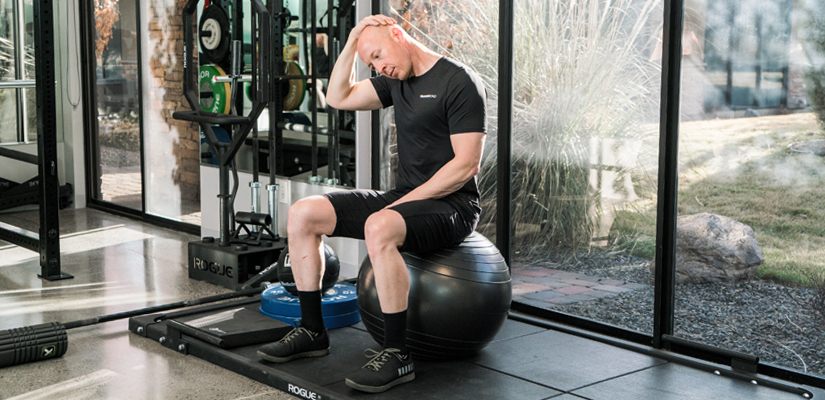
Integrating a stretching routine into your cycling training has practical benefits, despite being a contentious topic in the world of sports science. In this post, we’ll introduce you to 5 stretches for cyclists that can help improve your posture, increase your range of motion, and prepare your body to train and ride harder.
5 Stretches for Cyclists
- Neck Flexion Stretch
- Global Thoracic Extension
- Lumbar Mobility Repeats
- Bilateral Internal Rotation Stretch
- Couch Stretch
Stretches for Cyclists
Stretch 1: Neck Flexion Stretch
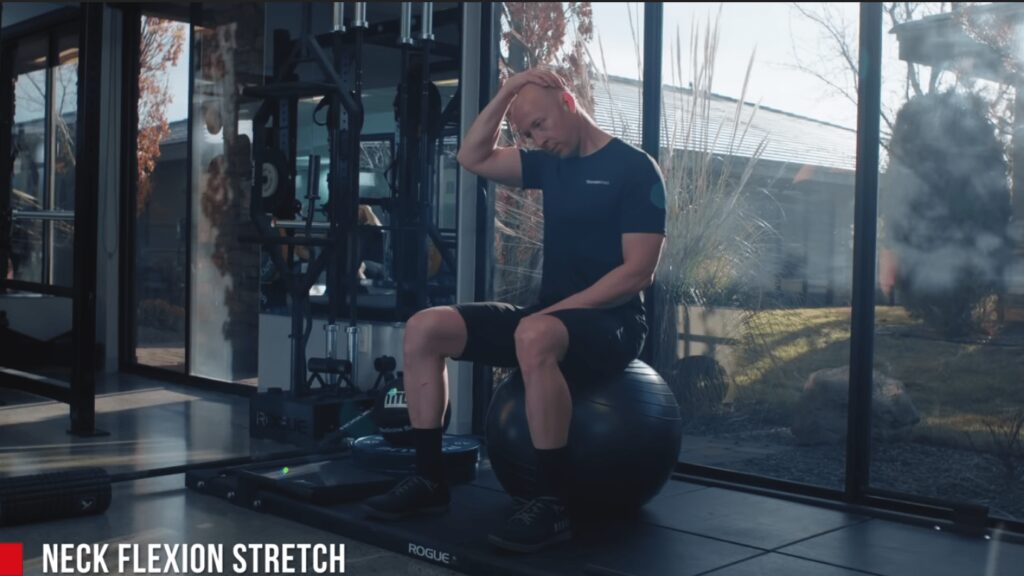
With this stretch for cyclists, you can address the neck muscles that are constantly in an overextended position on the bike. The neck flexion stretch aims to release that tension by pulling the head into a flexed position. In this stretch, you can target the cervical area of the spine in two ways. First, place a hand on top of your head. Then, while keeping both shoulders pulled back, slowly pull the chin to the chest. Second, put a hand on your head once more. Without letting our shoulders dip to either side, pull your head in the direction of the arm you’re using to facilitate the stretch.
Adaptive Training
Get the right workout, every time with training that adapts to you.
Check Out TrainerRoadStretch 2: Global Thoracic Extension
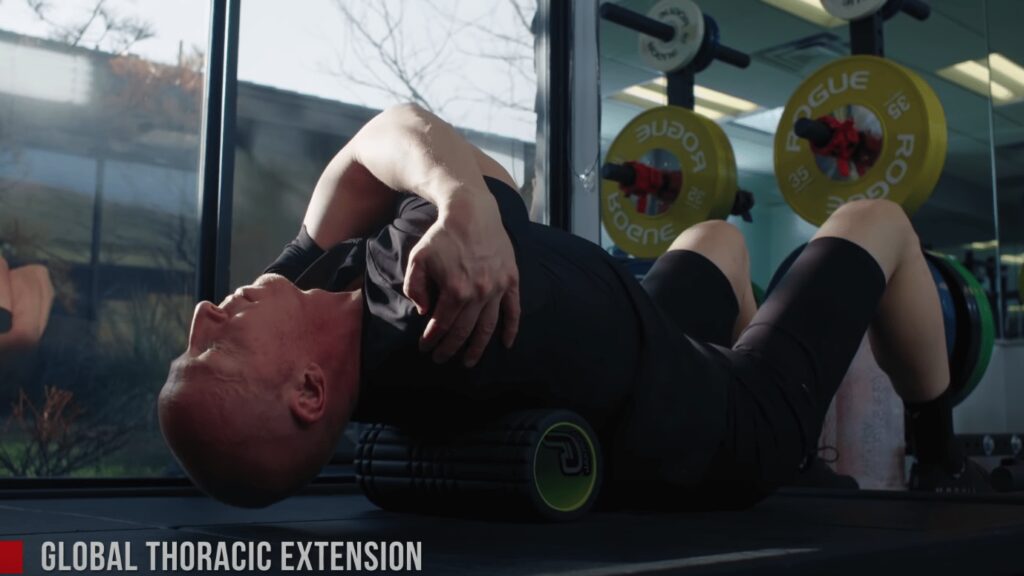
Whether at your desk or draped over a bicycle, the body tends to fold inward into an overly flexed position. To unlock the tension that arises because of it, you can target the thoracic section of the spine. This is the area between the upper and middle parts of your spine.
By extending the body over any number of surfaces, preferably something rounded, the spinal segments of the mid-back are opened up. This is an oscillation stretch. That means that you’ll repeat moving in & out of flex position by slowly letting our heads drop down and slowly lifting ourselves back up.
Optionally, you can get even more out of this stretch by reaching your arms overhead and bracing them on a weighted object, preferably a barbell or kettlebell. This further opens up the spine and frees stress in the anterior chain (chest and abdomen) as well as the thoracic segments of the spine. Instead of oscillating the upper body in the variant of this stretch, drop your hips and glutes to the ground in this instance.
Stretch 3: Lumbar Mobility Repeats
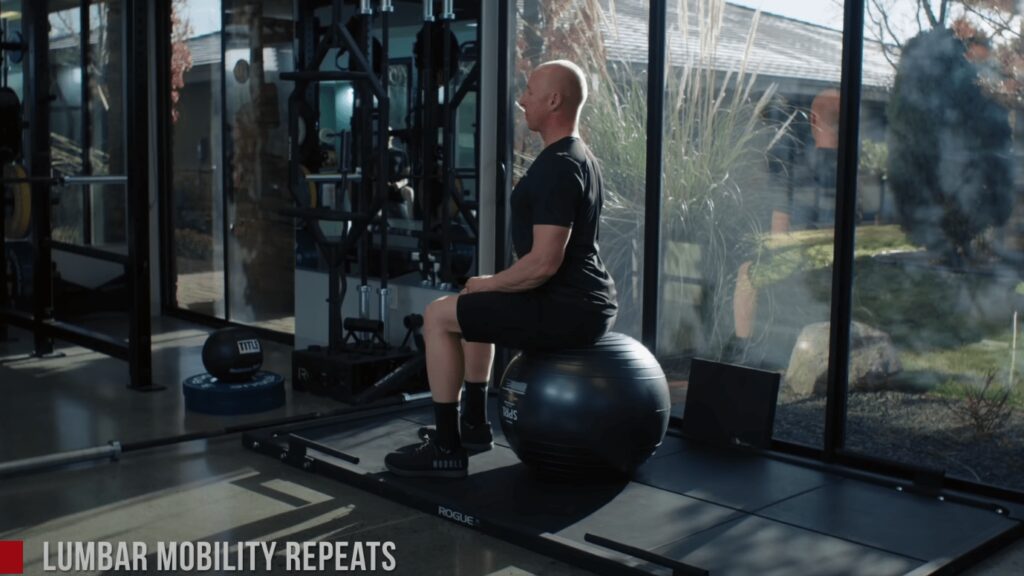
This is a fantastic stretch for cyclists. During a ride, many of us tend to have a poor posture on the bike. Similar to the mid-section of the spine, the lower back tends to become overly flexed from our on-, and off-the-bike routines. To combat the tension that arises in the vertebrae in the lumbar or lower area of the spine, you’ll simply overextend the lower back.
When you overextend in this position, you want to arch your spine, poof your chest out, and pull the shoulders down. We will also oscillate in and out of the position for this stretch by moving from a slightly hunched posture to the extended position we’ve just outlined. This stretch can be done sitting (like Coach Chad is demonstrating), on the bike, or standing.
Stretch 4: Bilateral Internal Rotation Stretch
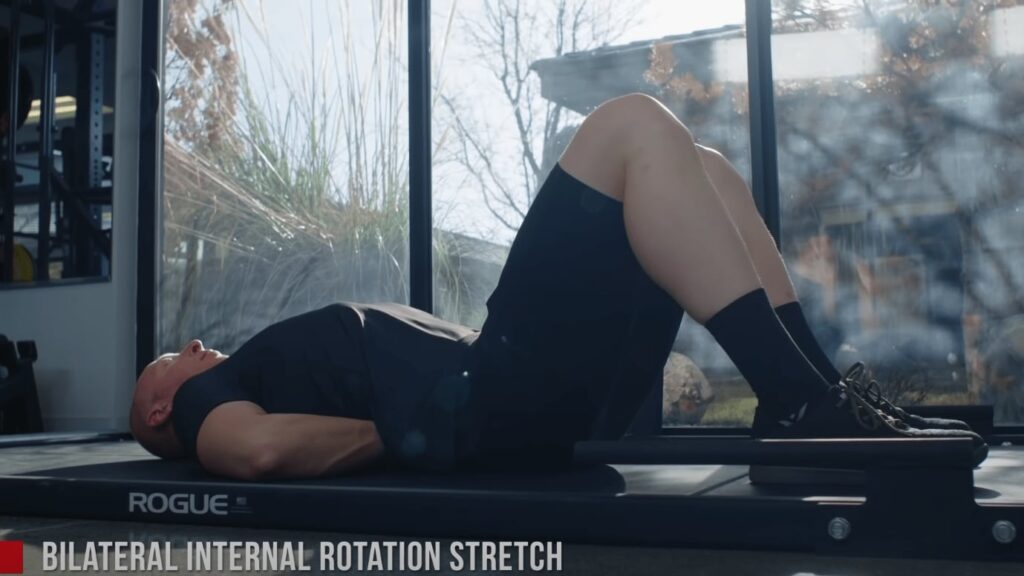
Whether it’s handlebars, your steering wheel, or from typing at a computer all day, your upper limbs become internally rotated. To counter the symptoms caused by internally rotated shoulders, this stretch targets tightness in the chest.
You want to lay flat on a surface with your knees up and feet flat on the floor. Slightly lift the middle and lower sections of the back and inner-lace your fingers underneath your back. While keeping your shoulders flat on the ground, slowly drop your back downward. Feel free to move the position of the hands along the back to find where this stretch is most effective for you.
You can take this stretch to another level with the help of a friend. When dropping the spine down to the ground with our hands interlocked along the back, a friend will push your shoulders down to ensure they are completely flat on the ground.
Stretch 5: Couch Stretch
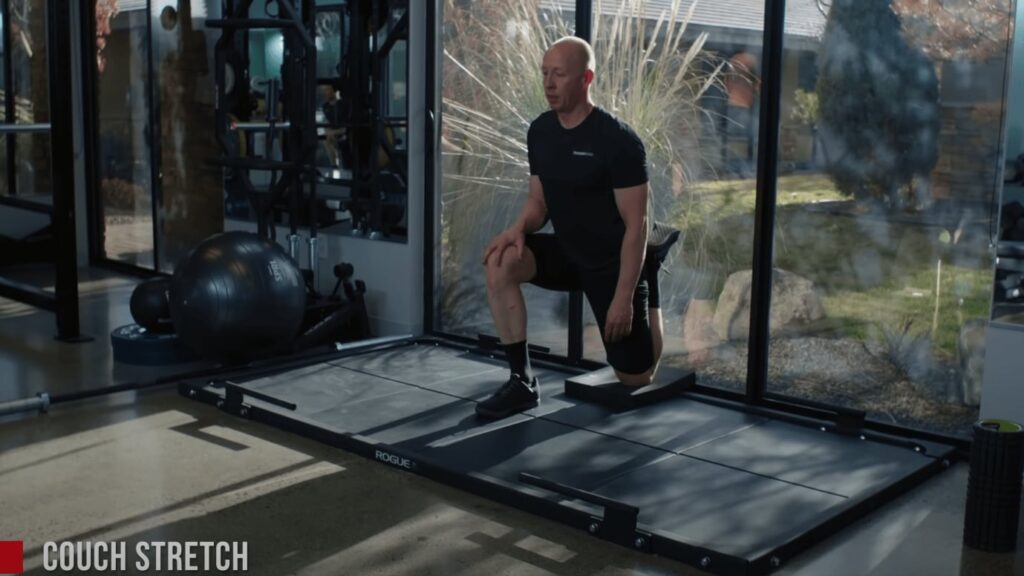
This stretch for cyclists is one of the best that you can do. It addresses both the hip flexors and the quadriceps, two areas chronically tight in cyclists. The couch stretch is a static stretch where you’ll hold a knee-flexed/hip-extended position.
First, place your feet up against a wall, or shin up against a couch, with your knee making contact with the ground/couch. To maintain balance, place your other leg at a 90-degree angle, then slowly straighten your back to make as vertical a line as possible from the head down through the knee of the leg you’re stretching.
If you want to increase the intensity of this stretch, contract the gluteal (butt) muscle of the stretched leg to further the stretch on the quads and hip flexors.
Stretching Duration and Frequency
Static stretches for cyclists need to be held for at least 30 seconds, and 2-3 minutes is even better. The oscillating stretches follow the same recommendation but with continuous movement. Your stretching routine should be a daily commitment to take full advantage of these potential benefits. The good news is that you can do these stretches while watching television or any free time that you have.
Why Should Cyclists Stretch?
Let’s be frank, the sport of cycling isn’t exactly forgiving when it comes to the tension that results from numerous hours of training, riding, and racing. You can restore normalcy to your body posture and break any unhealthy tendencies caused from your bike position by making stretching a regular practice within your typical training schedule.
Benefits of a Cycling Stretching Routine
First and foremost, stretching can help restore the body’s natural posture by stretching adaptively shortened muscles, caused by maintaining riding position. Cycling stretches can remove limitations that affect your ability to move pain-free, through each joint’s full range of motion. Of course, overall health and mobility are important off the bike as well. These stretches provide a framework for addressing other non-fitness aspects of cycling that carry beyond being faster—being comfortable in day-to-day life.
Finally, many cyclists find stretching relaxing, which can reduce stress and generally make you feel better. Many of our athletes enjoy stretching as part of their nighttime routine to increase sleep quality.
What Are the Best Stretches for Cyclists?
Essentially, you want movements that properly align the spine and loosen both the pelvic and shoulder girdles. These are the parts of the body subject to becoming overly tightened from riding on the bike. To achieve each of these mentioned benefits, the stretching routine we recommend utilizes two different stretching techniques.
The first technique is known as Proprioceptive Neuromuscular Facilitation (PNF). PNF is a stretching technique proven useful for increasing muscle elasticity and results in an improved range of motion both actively and passively. With this type of stretching, the brain signals to the muscles that it’s ok to relax. PNF techniques begin with a hold and relax. Then, you’ll contract the muscle and relax it again.
Our stretching routine concludes with two stretches using the technique of oscillation. Oscillation in the context of stretching refers to the technique of back and forth motions, in and out of a flex position. These are often referred to as dynamic stretches.
Can Stretching Increase Performance?
We’re not going to say that stretching will be the deciding factor on race day. We will say that stretching is understood better than ever before, and research supports an increased range of motion as a result of including PNF and oscillation stretches into a training routine.
- Does stretching for cyclists mean better performance? Maybe, not directly.
- Does stretching increase an athlete’s range of motion? Yes.
- Does increased range of motion allow potential for an enhanced training benefit? If more muscle can be stimulated due to increases in range of motion, yes.
- Does tension on the bike from overly tightened muscles mount and increase perceived effort? Yes.
- Can stretching decrease that tension in those overly stimulated muscles? Yes.
If we can gain enhanced training benefits from increases in range of motion, and if we can reduce perceived effort from mounting muscular tension, we’d argue stretching will result in performance increases.
When Should I Stretch?
Should you stretch before a bike ride? The short answer is that it most likely doesn’t help and could even lead to injury. Studies have shown that stretching before a workout doesn’t decrease muscle soreness. In cold conditions, stretching before activity can increase the chance of injury. That said, most of the stretching for cyclists is done to correct range of motion and posture.
Instead of stretching before a bike ride, it would be better to complete some muscle activation exercises. Once you’re on the bike, complete a thorough warm-up. These are included in every TrainerRoad workout. During your ride, take note of how your body is feeling. After your ride, you can address mobility issues with our recommended stretches.
Conclusion
We’re not going to sit here and claim stretching will immediately lead to better performance. There is evidence that reveals this isn’t the case for a variety of sports. What we will say is we believe restoring the body’s natural posture is beneficial for reasons beyond performance. We will also say that increases in range of motion as a result of stretching can lead to enhanced training benefits that may translate to better performances down the road.
For more cycling training knowledge, listen to the Ask a Cycling Coach Podcast— the only podcast dedicated to making you a faster cyclist. New episodes are released weekly.
References
- Hindle, Kayla B. et al. “Proprioceptive Neuromuscular Facilitation (PNF): Its Mechanisms and Effects on Range of Motion and Muscular Function.” Journal of Human Kinetics 31 (2012): 105–113. PMC. Web. 1 Feb. 2018.
- Funk DC, Swank AM, Mikla BM, Fagen TA, Farr BK. “Impact of Prior Exercise on Hamstring Flexibility: A Comparison of Proprioceptive Neuromuscular Facilitation and Static Stretching.” Natl Str Cond Assoc J. 2003;17(3):489–492.
- Dimitris, Chatzopoulos et al. “Acute Effects of Static and Dynamic Stretching on Balance, Agility, Reaction Time and Movement Time”J Sports Sci Med. May. 2014;13(2): 403-409
